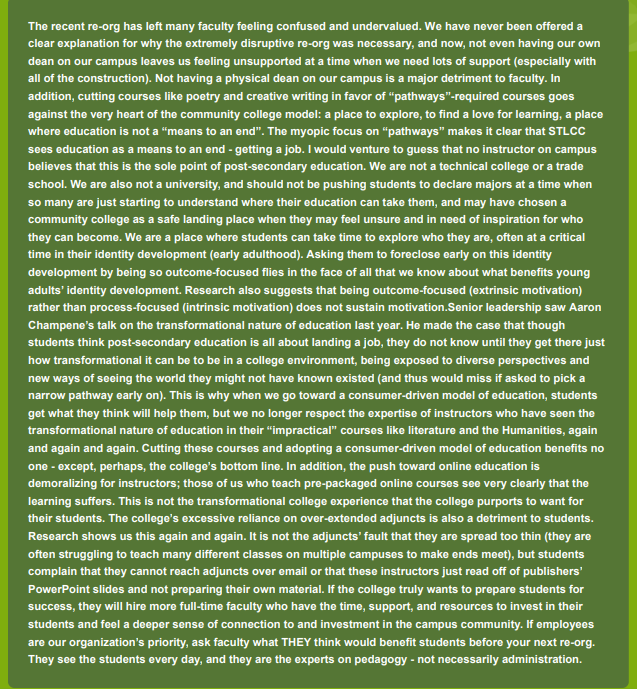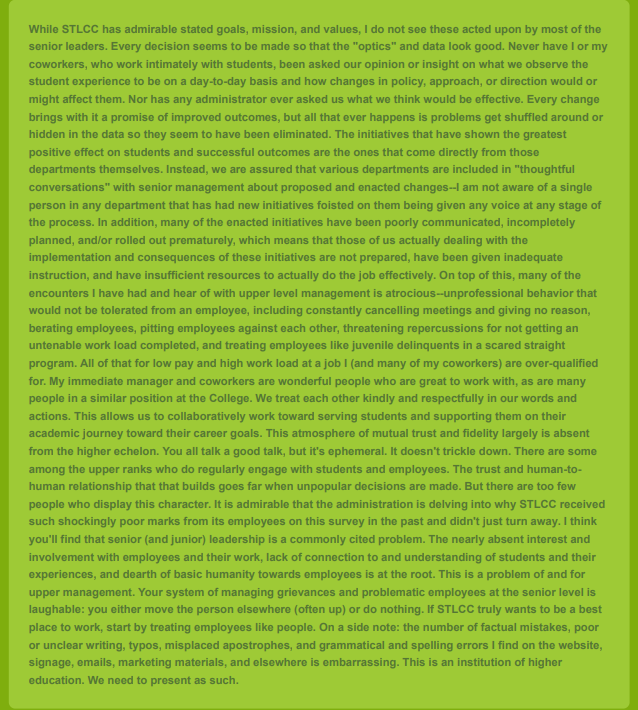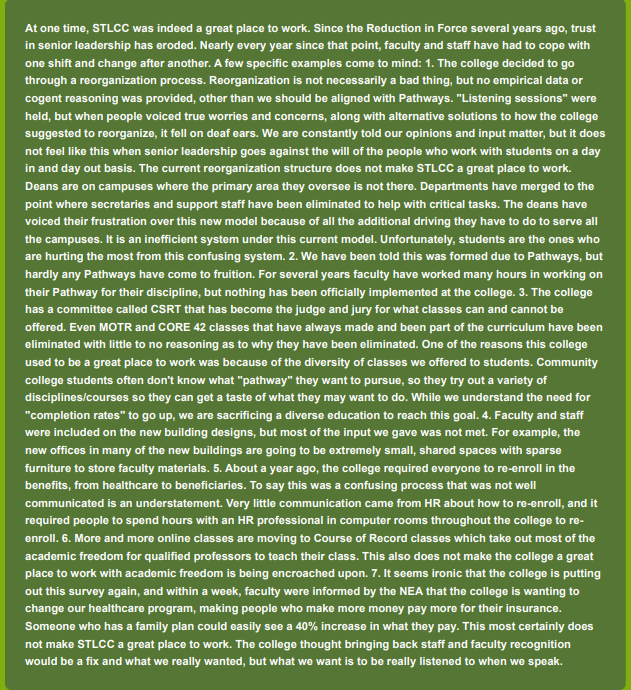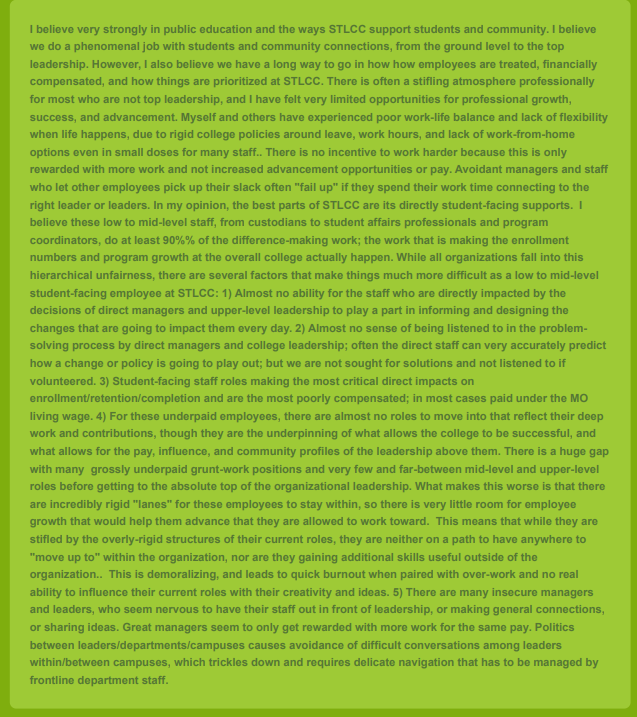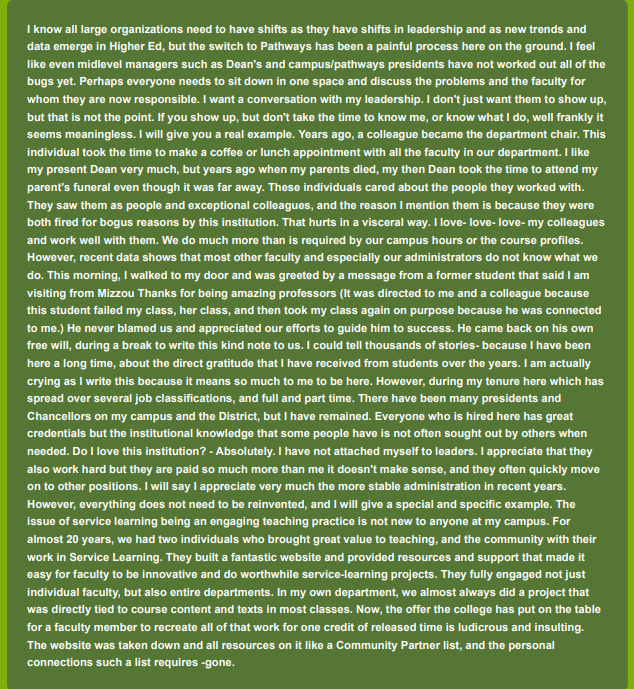The 2025 survey results show continued frustrations with Pathways, the recent academic reorganization and college leadership. Chancellor Pittman responds.
BY: JACOB POLITTE
Managing Editor
STLCC once again participated in the St. Louis Business Journal’s “Best Place To Work” survey and much like the last survey, it appears that the college has some things to address despite some visible improvements.
STLCC managed an overall score of 70.14, down nearly a full percentage point from the 2023 score of 70.93. In a message to faculty and staff on the day of the report’s release, Chancellor Jeff Pittman said, “Our leadership team and I are committed to addressing the areas for improvement highlighted in the survey.”
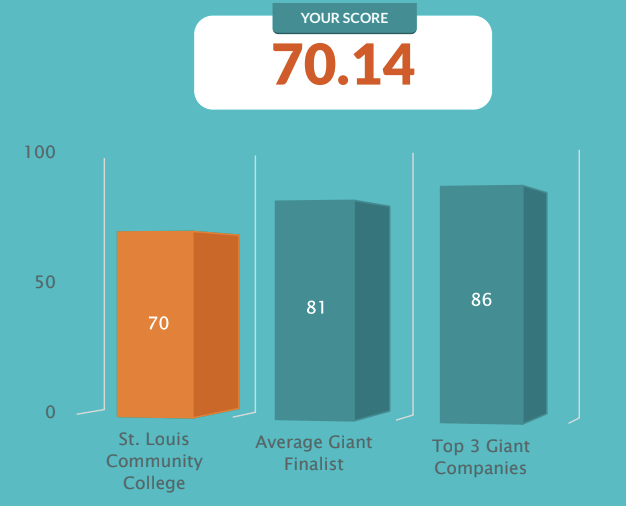
Speaking to The Montage late last week, Pittman said that he doesn’t dwell on the overall score, instead focusing on the rest of the survey, which he considered to be an overall improvement from two years ago.
“It looks like we’re making progress,” he said. “Not only with our metrics of student enrollment and completion and other metrics. I was also encouraged by the higher level of engagement that we saw from the employees. And that can be hard getting engagement, because we’re spread across four campuses. So I thought the results of it went pretty well.”
While the 637 faculty and staff who participated in the survey left over 2,000 comments, those highlighted in the survey mostly centered around two main criticisms.
Pathways and Re-Org face criticism
A recurring frustration from a sample of the responses provided in the report centers around the college’s new Pathways initiative and the overall nature of the recent reorganization of Academic Affairs across college campuses.
One anonymous comment reads, “The recent re-org has left many faculty feeling confused and undervalued. We have never been offered a clear explanation for why the extremely disruptive re-org was necessary, and now, not even having our own dean on our campus leaves us feeling unsupported at a time when we need lots of support (especially with all of the construction). Not having a physical dean on our campus is a major detriment to faculty.”
That particular commenter also lamented the elimination of courses like poetry and creative writing in favor of “Pathways” required courses.
They said that it “goes against the very heart of the community college model: a place to explore, to find a love for learning, a place where education is not a “means to an end”. The myopic focus on “Pathways” makes it clear that STLCC sees education as a means to an end – getting a job. I would venture to guess that no instructor on campus believes that this is the sole point of post-secondary education.”
They continued, “We are a place where students can take time to explore who they are, often at a critical time in their identity development (early adulthood). Asking them to foreclose early on this identity development by being so outcome-focused flies in the face of all that we know about what benefits young adults’ identity development.”
Another comment that also addressed senior leadership focused on the reorganization, echoing the comments above.
“The college decided to go through a reorganization process,” they said. “Reorganization is not necessarily a bad thing, but no empirical data or cogent reasoning was provided, other than we should be aligned with Pathways. ‘Listening sessions’ were held, but when people voiced true worries and concerns, along with alternative solutions to how the college suggested to reorganize, it fell on deaf ears.”
They continued, “The current reorganization structure does not make STLCC a great place to work. Deans are on campuses where the primary area they oversee is not there. Departments have merged to the point where secretaries and support staff have been eliminated to help with critical tasks. The deans have voiced their frustration over this new model because of all the additional driving they have to do to serve all the campuses. It is an inefficient system under this current model. Unfortunately, students are the ones who are hurting the most from this confusing system.”
Chancellor Pittman responded to these sentiments by acknowledging that the reorganization was not perfect. But he did note the success in enrollment and completion rates, attributing it to the “Pathway” model.
“I mean, certainly, anytime you try something of that magnitude, it’s probably not gonna go perfect,” he said. “And we moved Deans around to different campuses. Maybe faculty felt a little bit insecure that they don’t have their particular Dean at a campus. But I think they’ll adapt to that. I really do.”
He continued, “It’s so easy to reach out to someone with instant communications using teams or Zoom or phone, a lot of things, if that’s where the concern is. But I think overall, given the success we’re seeing with our enrollment and increasing completion rates with students, clearly this Pathway initiative has worked very well.”
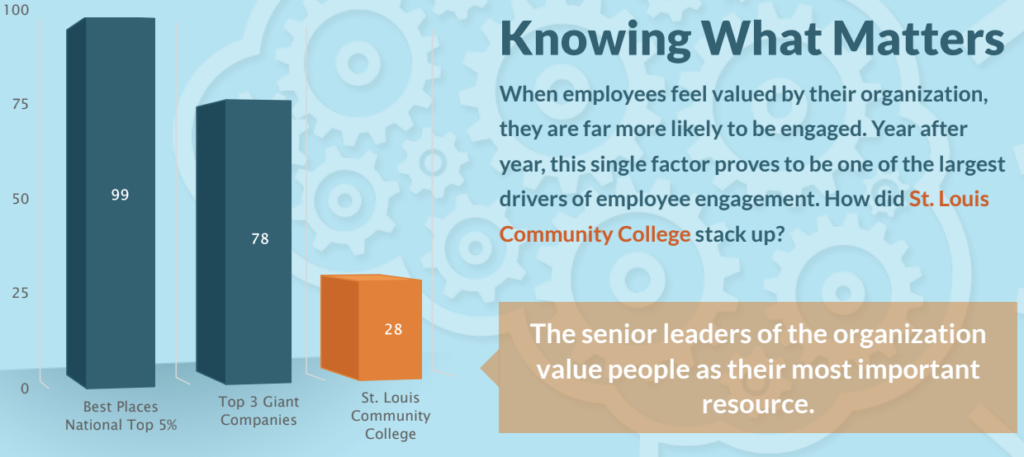
College leaders criticized as not hearing concerns
Much like in the 2023 survey results, senior leadership at the college was also heavily criticized.
One comment reads, “While STLCC has admirable stated goals, mission, and values, I do not see these acted upon by most of the senior leaders. Every decision seems to be made so that the “optics” and data look good. Never have I or my coworkers, who work intimately with students, been asked our opinion or insight on what we observe the student experience to be on a day-to-day basis and how changes in policy, approach, or direction would or might affect them. Nor has any administrator ever asked us what we think would be effective. Every change brings with it a promise of improved outcomes, but all that ever happens is problems get shuffled around or hidden in the data so they seem to have been eliminated.”
They later continued, “Many of the encounters I have had and hear of with upper level management is atrocious–unprofessional behavior that would not be tolerated from an employee, including constantly cancelling meetings and giving no reason, berating employees, pitting employees against each other, threatening repercussions for not getting an untenable work load completed, and treating employees like juvenile delinquents in a scared straight program. All of that for low pay and high workload at a job I (and many of my coworkers) are overqualified for.”
The criticism of higher-level leadership did not stop there. They continued, “This atmosphere of mutual trust and fidelity largely is absent from the higher echelon. You all talk a good talk, but it’s ephemeral. It doesn’t trickle down. There are some among the upper ranks who do regularly engage with students and employees. The trust and human-to-human relationship that that builds goes far when unpopular decisions are made. But there are too few people who display this character.”
“The nearly absent interest and involvement with employees and their work, lack of connection to and understanding of students and their experiences, and dearth of basic humanity towards employees is at the root. This is a problem of and for upper management. Your system of managing grievances and problematic employees at the senior level is laughable: you either move the person elsewhere (often up) or do nothing. If STLCC truly wants to be a best place to work, start by treating employees like people.”
All but one of those whose comments were highlighted in the survey reported not feeling heard or listened to by upper management. One commenter who appears to be a long-time college faculty member left, “I want a conversation with my leadership. I don’t just want them to show up, but that is not the point. If you show up, but don’t take the time to know me, or know what I do, well frankly it seems meaningless.”
Pittman said that the college took steps to address the feedback received in the 2023 survey. These included: increasing executive visibility, improving facilities management, and streamlining purchasing processes.
“There were concerns brought forward by the fix it ticketing process for facilities managers, facilities matters, and we’ve improved those,” he said. There were challenges we had with our purchasing cards, and we improved those things. We had issues with getting things paid on time, you know, through finance, and we really picked up the pace and improved on that. There was also a lot of interest in return of the reward and recognition program. So you’re going to see a lot more of those [kinds of things].”
When asked to elaborate on what exactly “increased executive visibility” entailed, Pittman said that it means that you’re likely to see more college leadership members at various campus events, like faculty lecture awards or other kinds of presentations.
“What I understand that to mean is that they wanted to see us at them,” he said. “So I go out to different events, and the Cabinet goes out to different events. And when they say senior leadership, I don’t know if they’re talking about me or the cabinet or who they’re talking they’re talking about their supervisor, they’re talking about their dean, but what we’re asking all the leaders is to attend these events that are occurring.”
Benefits go up, but are set to change
The college’s benefit score on this year’s survey increased by almost 40 points since the previous one. However, changes are coming to the college’s health insurance.
The college is self-insured, and will continue to be. The insurance administrator will still be Cigna. Pittman said that the college proposed several changes and received a lot of feedback from faculty, noting that a suggestion to use “salary bands” was not implemented because of that feedback. He also said that the college was moving away from using the so-called “Buy-A-Plan” used by many of the college’s higher-paid employees, including some faculty.
“It was a very expensive feature in our overall healthcare benefit plan that we just couldn’t sustain,” Pittman said. “It was getting to the point where it was getting so expensive that we couldn’t maintain it.”
Pittman claimed that the college had close to $20 million in claims last year. The college will keep its base plan, and Pittman himself will be one of those affected by the change, moving to that plan.
“We just have to be able to moderate our budget so we can keep it sustainable,” he said. “We also kept the high deductible for individuals that you know, if you’re in really good health, you don’t really need to pay extra for health care insurance, typically.”
Pittman acknowledged that by getting rid of the “Buy-A-Plan,” some insurance premiums will go up.
“But given how much our everything went up this last year, we just had to make some adjustments,” he said.
Meramec Nursing and Financial Services
One comment in the 2023 survey addressed the lack of a new building for the nursing program at Meramec. In light of the recent completion of the new nursing center at the Florissant Valley campus and the new simulation labs at the South County campus, Pittman was again asked about it. He noted that it’s not something in the plans right now, but that could change over time.
He also said that he considered the South County campus to be a part of the Meramec community, noting that further expansions of the nursing program can take place there in the future.
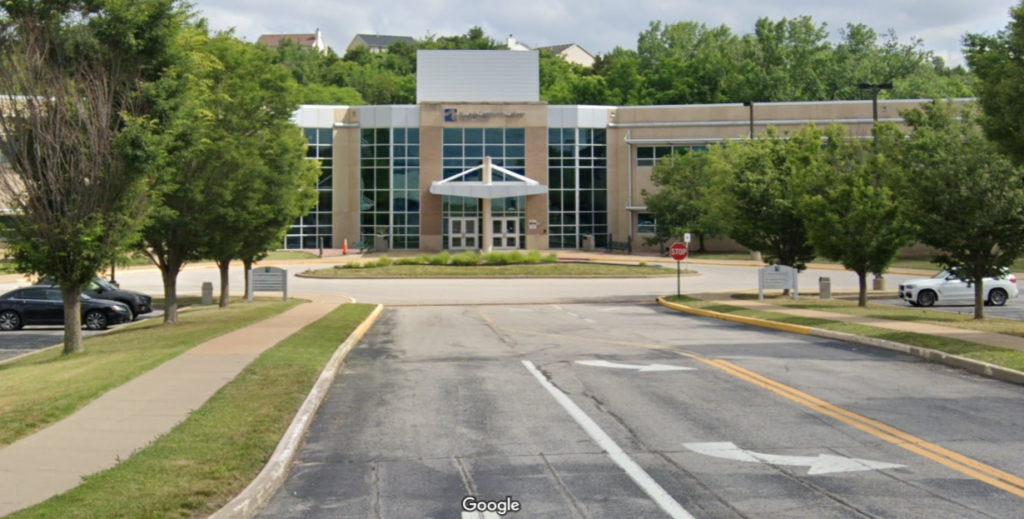
“We’ve expanded nursing down in South County, which is a part of the Meramec campus,” he said. “We have a lot of resources for Meramec that I think we haven’t been capitalizing on in the past. And I think South County is a big example of that.”
He continued, “Certainly nothing’s off the table if, if we do were to get additional resources and support, it might very well make sense to put another healthcare building at Meramec. We were trying to spread the resources we received from the local taxpayers by focusing on different workforce sectors. In Meramec’s case, we’re focusing on financial services, and we improved the library. We also are focusing on horticulture, because it’s just a high demand program that has a waitlist of students trying to get in it.”
Pittman said that the college “didn’t think we’d want to do the same thing at every campus. You know? We wanted to keep the variety.”
He noted that Meramec has a culture around transfer programs and transfer students and financial services “certainly makes a lot of sense.”
“In many cases, students want to go on and get even an MBA, or graduate degrees in finance,” Pittman said. “A lot of our leaders in the St Louis community that head a banking institution started a Meramec. So we’ve seen a lot of success come out of that campus. We thought it’d be a logical fit.”
Pittman’s final thoughts
The Chancellor again reiterated that he wasn’t surprised that the overall score didn’t change.
“I was more interested in the actual engagement data that came out of this, where it looks like we’re actually starting to pull more people in and have these conversations,” he said. “That’s the most important thing to me.”
Pittman also reflected on his tenure at STLCC; on July 1, he will have served as Chancellor of the college for a full decade.
“I feel incredibly blessed that I’ve had this opportunity to serve here that long,” he said. “But I give the credit to the faculty and staff. I mean, they really have stepped up. When I arrived here in 2015, I was the fifth Chancellor in eight years, and there had been so much turnover and confusion, not only at the district level, but at the campus level, where Presidents would kind of revolve in and out all the time. So we have a solid team now that has stuck with it. Our team has bought into the mission of serving students, certainly the faculty have as well. You know, I’m really, really proud of the faculty. I’m really proud of the staff, the employees.”
To read all of the comments left on the 2025 survey in full, keep reading below.
